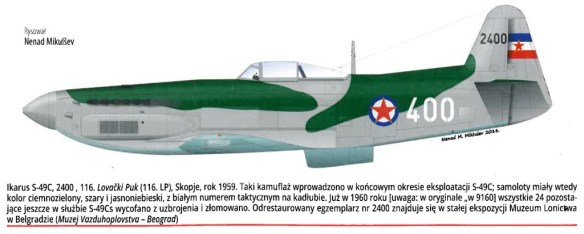The first postwar fighter to be designed in Yugoslavia, the S- 49 was a development of the prewar Ikarus IK-3, production of which had been halted by the German invasion after only a few evaluation aircraft had been completed. The prototype flew in 1948, powered by a Klimov VK-105PF-2 liquid-cooled engine, and the first examples entered service as the S-49A in 1951. Subsequent aircraft were powered by the Hispano-Suiza 12Z-11Y engine, purchased after Yugoslavia severed relations with the USSR. In this guise, and with other refinements, the aircraft emerged as the S-49C.
The Ikarus S-49 was a Yugoslav single-seat, single-engine fighter aircraft built for the Yugoslav Air Force (Serbo-Croatian: Ratno vazduhoplovstvo i protivvazdušna obrana – RV i PVO) shortly after World War II. Following the Tito–Stalin Split in 1948, the RV i PVO was left with an aircraft inventory consisting of mostly Soviet aircraft. Unable to acquire new aircraft or spare parts for its existing fleet, the RV i PVO turned to its domestic aviation industry in order to create an indigenous design to fulfill the need for additional aircraft.
The same constructors that built the Rogozarski IK-3 before the war, engineers Kosta Sivcev, Slobodan Zrnic and Svetozar Popovic, used existing technical documentation of the IK-3 to construct the new fighter aircraft, the Ikarus S-49.
The S-49A was of mixed construction, with Soviet-built VK-105 engines held in stock, which were no longer available after 1948. Therefore, it was decided to produce a new version of the aircraft powered by the similar French Hispano-Suiza 12Z-17 engine. Because of the bigger and heavier engine, the new aircraft had to be of all-metal construction with a much longer nose. While the aircraft were mainly built by Ikarus, the wings and tail were built by the SOKO factory in Mostar. The armament consisted of one 20 mm Mauser MG-151/20 autocannon produced by Germany during World War II and two 12.7 mm Colt-Browning machine guns. In addition, underwing racks for two 50 kg bombs or four 127 mm HVAR missiles were provided.
The first prototype of the S-49A flew in June 1949. The first operational aircraft were delivered to combat units at the beginning of 1950.
An S-49B Ikarus had been proposed with the German DB-605 engine, but for mass production the Ikarus S-49C was chosen.
The S-49A was superseded by the improved S-49C, featuring an all-metal construction and a more powerful engine. The Ikarus S-49C went into service with the units of the Yugoslav Air Force at the beginning of 1952.
The aircraft factory “Soko” produced the assembly of the wing and empennage for the S-49C fighter, starting in 1952. An all-metal version of the S-49A powered by a Hispano Suiza HS 12Z-17. Underwing mounts were fitted for rockets, MG-151 or Colt-Browning M2 12.7- mm machine guns, or two 50-kg bombs.
A total of 45 S-49A and 113 S-49C were produced by the Ikarus Aircraft Factory in Zemun. The last aircraft were retired from RV i PVO service in 1960/61, having been replaced by more modern jet-powered aircraft.
Variants
S-49A – mixed construction and Klimov M-105 engine (45 built)
S-49B – planned version powered by a Daimler-Benz engine; unbuilt.
S-49C – all-metal construction and Hispano-Suiza 12Z engine (113 built)
Operators:
Yugoslav Air Force
Ikarus S-49A – 46 aircraft (1949–1957)
117th Fighter Aviation Regiment (1950–1953)
204th Fighter Aviation Regiment (1950–1953)
107th Fighter Aviation Regiment (1953–1957)
Training Squadron of 44th Aviation Division (1953–1954)
Ikarus S-49C – 112 aircraft (1952–1961)
116th Fighter Aviation Regiment (1952–1960)
185th Fighter Aviation Regiment (1953–1956)
40th Fighter Aviation Regiment (1955–1959)
109th Fighter Aviation Regiment (1956–1960)
88th Fighter Aviation Regiment (1957–1959)
Training Squadron of 39th Aviation Division (1953–1959) S-49C
Specifications:
S-49A
Engine: Klimov VK-105PF, 1180 hp
Wingspan: 10.30 m
Length: 8.43 m
Height: 3.20 m
Wing area: 16.60 sq.m
Empty weight: 2320 kg
Normal take-off weight: 2950 kg
Maximum speed: 554 kph
Range: 690 km
Rate of climb: 1026 m / min
Ceiling: 10,000 m
Crew: 1
Armament:
1 x 20-mm motorpushka ShVAK with 120 rounds
2 x 12.7 mm UBS machine gun with 200 rounds
S-49C
Engine: 1 × Hispano-Suiza 12Z-17, 1,104 kW (1,500 hp)
Length: 9.06 m (29 ft 83in)
Wingspan: 10.30 m (33 ft 91 in)
Height: 2.90 m (9 ft 6 in)
Wing area: 16.65 m2 (179 ft2)
Empty weight: 2,818 kg (6,200 lb)
Max. takeoff weight: 3,568 kg (7,850 lb)
Maximum speed: 628 km/h (339 knots, 390 mph) at 1,525 m (5,000 ft)
Range: 690 km (373 nm, 429 mi)
Service ceiling: 10,000 m (33,000 ft)
Climb to 6,000 m (19,700 ft): 6 min 54 sec
Armament
1 × 20 mm MG-151/20 cannon
2 × .50 Colt Browning M2 machine guns with 650 rounds per gun
2 × 50 kg (110 lb) bombs or 4 × 5 in HVAR missiles
Crew: one pilot
